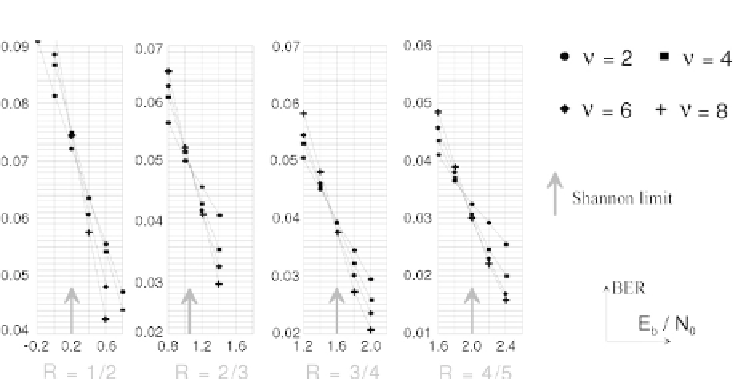Cryptography Reference
In-Depth Information
Figure 7.1 - Performance of recursive systematic convolutional codes (RSC) for dif-
ferent rates and four values of the memory of code
ν
.
Comparison with Shannon
limits.
[7.26], etc. had earlier imagined procedures for coding and decoding that were
the forerunners of turbo codes.
In a laboratory at École Nationale Supérieure des Télécommunications de
Bretagne (Telecom Bretagne), Claude Berrou and Patrick Adde were attempt-
ing to transcribe the Viterbi algorithm with weighted input (SOVA:
Soft-Output
Viterbi Algorithm
) proposed in [7.7], into MOS transistors, in the simplest possi-
ble way. A suitable solution [7.10] was found after two years which enabled these
researchers to form an opinion about probabilistic decoding. Claude Berrou,
then Alain Glavieux, pursued the study and observed, after Gerard Battail,
that a decoder with weighted input and output could be considered as a sig-
nal to noise ratio amplifier. This encouraged them to implement the concepts
commonly used in amplifiers, mainly feedback. Perfecting turbo codes involved
many very pragmatic stages and also the introduction of neologisms, like "paral-
lel concatenation" or "extrinsic information", nowadays common in information
theory jargon. The publication in 1993 of the first results [7.14], with a perfor-
mance 0,5 dB from the Shannon limit, shook the coding community. A gain of
almost 3 dB, compared to solutions existing at that time, had been found by
a small team that was not only unknown, but also French (France, a country
known for its mathematical rigour,
versus
turbo codes, an empirical invention
to say the least). There followed a very distinct evolution in habits, as under-
lined by A. R. Calderbank in [7.20] (p. 2573): "
It is interesting to observe that
the search for theoretical understanding of turbo codes has transformed coding
theorists into experimental scientists
"
[7.13] presents a chronology describing the successive ideas that appeared in
the search to perfect turbo codes. This new coding and decoding technique was



